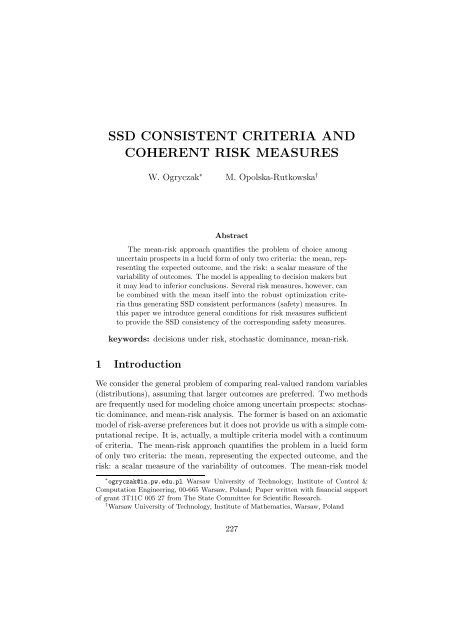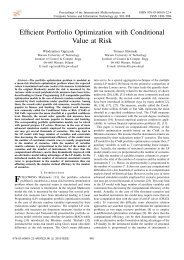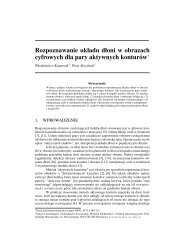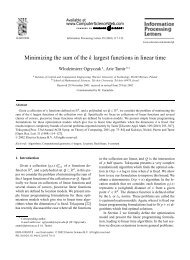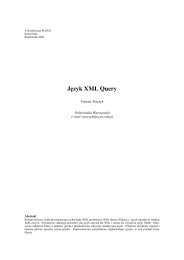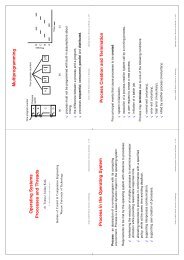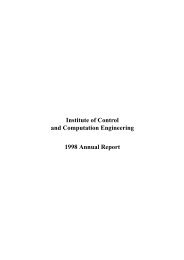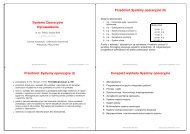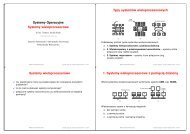SSD CONSISTENT CRITERIA AND COHERENT RISK MEASURES
SSD CONSISTENT CRITERIA AND COHERENT RISK MEASURES
SSD CONSISTENT CRITERIA AND COHERENT RISK MEASURES
Create successful ePaper yourself
Turn your PDF publications into a flip-book with our unique Google optimized e-Paper software.
<strong>SSD</strong> <strong>CONSISTENT</strong> <strong>CRITERIA</strong> <strong>AND</strong><br />
<strong>COHERENT</strong> <strong>RISK</strong> <strong>MEASURES</strong><br />
W. Ogryczak ∗ M. Opolska-Rutkowska †<br />
Abstract<br />
The mean-risk approach quantifies the problem of choice among<br />
uncertain prospects in a lucid form of only two criteria: the mean, representing<br />
the expected outcome, and the risk: a scalar measure of the<br />
variability of outcomes. The model is appealing to decision makers but<br />
it may lead to inferior conclusions. Several risk measures, however, can<br />
be combined with the mean itself into the robust optimization criteria<br />
thus generating <strong>SSD</strong> consistent performances (safety) measures. In<br />
this paper we introduce general conditions for risk measures sufficient<br />
to provide the <strong>SSD</strong> consistency of the corresponding safety measures.<br />
keywords: decisions under risk, stochastic dominance, mean-risk.<br />
1 Introduction<br />
We consider the general problem of comparing real-valued random variables<br />
(distributions), assuming that larger outcomes are preferred. Two methods<br />
are frequently used for modeling choice among uncertain prospects: stochastic<br />
dominance, and mean-risk analysis. The former is based on an axiomatic<br />
model of risk-averse preferences but it does not provide us with a simple computational<br />
recipe. It is, actually, a multiple criteria model with a continuum<br />
of criteria. The mean-risk approach quantifies the problem in a lucid form<br />
of only two criteria: the mean, representing the expected outcome, and the<br />
risk: a scalar measure of the variability of outcomes. The mean-risk model<br />
∗ ogryczak@ia.pw.edu.pl Warsaw University of Technology, Institute of Control &<br />
Computation Engineering, 00-665 Warsaw, Poland; Paper written with financial support<br />
of grant 3T11C 005 27 from The State Committee for Scientific Research.<br />
† Warsaw University of Technology, Institute of Mathematics, Warsaw, Poland<br />
227
is appealing to decision makers but it is not capable of modeling the entire<br />
gamut of risk-averse preferences. Moreover, for typical dispersion statistics<br />
used as risk measures, the mean-risk approach may lead to inferior conclusions.<br />
In this paper we analyze conditions that are necessary and sufficient for<br />
risk measures to provide the <strong>SSD</strong> consistency of the corresponding meanrisk<br />
models. Actually, we show that under simple and natural conditions on<br />
the risk measures they can be combined with the mean itself into the robust<br />
optimization criteria thus generating <strong>SSD</strong> consistent performance (safety)<br />
measures. The analysis is performed for general distributions but we also<br />
pay attention to special cases such as discrete or symmetric distributions.<br />
We demonstrate that, while considering risk measures depending only on<br />
the distributions, the conditions similar to those for the coherency are, essentially,<br />
sufficient for <strong>SSD</strong> consistency.<br />
2 Stochastic dominance and mean-risk models<br />
In the stochastic dominance approach random variables are compared by<br />
pointwise comparison of some performance functions constructed from their<br />
distribution functions. Let X be a random variable representing some returns.<br />
The first performance function F 1 (X, r) is defined as the rightcontinuous<br />
cumulative distribution function itself: F 1 (X, r) = P[X ≤ r]<br />
for r ∈ R. We say that X weakly dominates Y under the FSD rules<br />
(X ≽ F SD<br />
Y ), if F 1 (X, r) ≤ F 1 (Y, r) for all r ∈ R, and X FSD dominates Y<br />
(X ≻ F SD<br />
Y ), if at least one strict inequality holds. Actually, the stochastic<br />
dominance is a stochastic order thus defined on distributions rather than<br />
on random variables themselves. Nevertheless, it is a common convention,<br />
that in the case of random variables X and Y having distributions P X and<br />
P Y , the stochastic order relation P X ≽ P Y might be viewed as a relation<br />
on random variables X ≽ Y [11]. It must be emphasized, however, that the<br />
dominance relation on random variables is no longer an order as it is not<br />
antisymmetric.<br />
The second degree stochastic dominance relation is defined with the second<br />
performance function F 2 (X, r) given by areas below the cumulative<br />
distribution function itself, i.e.: F 2 (X, r) = ∫ r<br />
−∞ F 1(X, t)dt for r ∈ R. Similarly<br />
to FSD, we say that X weakly dominates Y under the <strong>SSD</strong> rules<br />
(X ≽ <strong>SSD</strong><br />
Y ), if F 2 (X, r) ≤ F 2 (Y, r) for all r ∈ R, while X <strong>SSD</strong> dominates<br />
Y (X ≻ <strong>SSD</strong><br />
Y ), when at least one inequality is strict. Certainly, X ≻ F SD<br />
Y<br />
implies X ≻ <strong>SSD</strong><br />
Y . Function F 2 (X, r), used to define the <strong>SSD</strong> relation<br />
228
can also be presented as follows [12]: F 2 (X, r) = E[max{r − X, 0}], thus<br />
representing the mean below-target deviations from real targets.<br />
If X ≻ <strong>SSD</strong><br />
Y , then X is preferred to Y within all risk-averse preference<br />
models that prefer larger outcomes. In terms of the expected utility theory<br />
the <strong>SSD</strong> relation represent all the preferences modeled with increasing and<br />
concave utility functions. It is therefore a matter of primary importance<br />
that an approach to the comparison of random outcomes be consistent with<br />
the second degree stochastic dominance relation. Our paper focuses on the<br />
consistency of mean-risk approaches with the <strong>SSD</strong>.<br />
Alternatively, the stochastic dominance order can be expressed on the<br />
inverse cumulative functions (quantile functions). Namely, for random variable<br />
X, one may consider the performance function F −1 (X, p) defined as is<br />
the left-continuous inverse of the cumulative distribution function F 1 (X, r),<br />
i.e., F −1 (X, p) = inf {η : F 1 (X, η) ≥ p}. Obviously, X dominates Y under<br />
the FSD rules (X ≻ F SD<br />
Y ), if F −1 (X, p) ≥ F −1 (Y, p) for all p ∈ [0, 1], where<br />
at least one strict inequality holds. Further, the second quantile function<br />
(or the so-called Absolute Lorenz Curve ALC) is defined by integrating F −1 ,<br />
which provides an alternative characterization of the <strong>SSD</strong> relation,<br />
Mean-risk approaches are based on comparing two scalar characteristics<br />
(summary statistics), the first, denoted µ(X), represents the expected<br />
outcome (reward), and the second, denoted ϱ(X), is some measure of risk.<br />
The original Markowitz portfolio optimization model [9] uses the variance<br />
or the standard deviation. Several other risk measures have been later considered<br />
thus creating the entire family of mean-risk models. Risk measures<br />
in Markowitz-type mean-risk models, similar to the standard deviation, are<br />
translation invariant and risk relevant deviation type measures (dispersion<br />
parameters). Thus, they are not affected by any shift of the outcome scale<br />
ϱ(X + a) = ϱ(X) for any real number a and they are equal to 0 in the<br />
case of a risk-free portfolio while taking positive values for any risky portfolio.<br />
Unfortunately, such risk measures are not consistent with the stochastic<br />
dominance order [11]. Indeed, in the Markowitz model its efficient set may<br />
contain <strong>SSD</strong> inferior portfolios characterized by a small risk but also very low<br />
return [15]. Unfortunately, it is a common flaw of all Markowitz-type meanrisk<br />
models where risk is measured with some dispersion measures. In order<br />
to overcome this flaw of the Markowitz model, already Baumol [2] suggested<br />
to consider a performance measure, he called the expected gain-confidence<br />
limit criterion, µ(X) − λσ(X) to be maximized instead of the minimization<br />
of σ(X) itself. Similarly, Yitzhaki [18] considered maximization of the criterion<br />
µ(X) − ϱ(X) for the Gini’s mean difference and he demonstrated its<br />
<strong>SSD</strong> consistency. Recently, similar consistency results have been introduced<br />
229
[12, 13] for measures corresponding to the standard semideviation and to<br />
the mean semideviation (half of the mean absolute deviation).<br />
Hereafter, for any dispersion type risk measure ϱ(X), the performance<br />
function S(X) = µ(X)−ϱ(X) will be referred to as the corresponding safety<br />
measure. Note that risk measures, we consider, are defined as translation<br />
invariant and risk relevant dispersion parameters. Hence, the corresponding<br />
safety measures are translation equivariant in the sense that any shift of<br />
the outcome scale results in an equivalent change of the safety measure<br />
value (with opposite sign as safety measures are maximized), or in other<br />
words, the safety measures distinguish (and order) various risk-free portfolios<br />
(outcomes) according to their values. The safety measures, we consider, are<br />
risk relevant but in the sense that the value of a safety measure for any<br />
risky portfolio is less than the value for the risk-free portfolio with the same<br />
expected returns. Moreover, when risk measure ϱ(X) is a convex function<br />
of X, then the corresponding safety measure S(X) is concave.<br />
Relation of the <strong>SSD</strong> consistency of the safety measures directly involves<br />
criterion µ(X) − ϱ(X). However, the <strong>SSD</strong> dominance always implies the<br />
means inequality. Hence, in the case of X ≽ <strong>SSD</strong><br />
Y we have both µ(X) ≥<br />
µ(Y ) and µ(X)−ϱ(X) ≥ µ(Y )−ϱ(Y ). Thus, by combining inequalities, one<br />
may easily notice that X ≻ <strong>SSD</strong><br />
Y implies µ(X) − λϱ(X) ≥ µ(Y ) − λϱ(Y ) for<br />
all 0 ≤ λ ≤ 1. On the other hand, one may just consider ϱ β (X) = βϱ(X) as<br />
a basic risk measure, like the mean absolute semideviation equal to the half<br />
of the mean absolute deviation itself. In such a case one may gets another<br />
(possibly higher) upper bound for the trade-off coefficient guaranteeing the<br />
<strong>SSD</strong> consistency. Therefore, following [12], in this paper we say that the<br />
(deviation) risk measure is <strong>SSD</strong> α-safety consistent if there exists a positive<br />
constant α such that for all X and Y :<br />
X ≽ <strong>SSD</strong><br />
Y ⇒ µ(X) − α ϱ(X) ≥ µ(Y ) − α ϱ(Y ). (1)<br />
For the sake of simplicity, the <strong>SSD</strong> 1-safety consistency of a risk measure we<br />
will usually call simply <strong>SSD</strong> safety consistency. The relation of <strong>SSD</strong> (safety)<br />
consistency is called strong if, in addition to (1), the following holds<br />
X ≻ <strong>SSD</strong><br />
Y ⇒ µ(X) − α ϱ(X) > µ(Y ) − α ϱ(Y ). (2)<br />
An important advantage of mean-risk approaches is that having assumed<br />
a trade-off coefficient λ between the risk and the mean, one may directly<br />
compare real values of µ(X) − λϱ(X). If the risk measure ϱ(X) is <strong>SSD</strong><br />
α-safety consistent, then except for random variables with identical µ(X)<br />
and ϱ(X), every random variable that is maximal by µ(X) − λϱ(X) with<br />
230
0 < λ < α is efficient under he <strong>SSD</strong> rules. In the case of strong <strong>SSD</strong><br />
safety consistency, every such maximal random variable is, unconditionally,<br />
<strong>SSD</strong> efficient. Therefore, the strong <strong>SSD</strong> safety consistency is an important<br />
property of a risk measure.<br />
The stochastic dominance partial orders are defined on distributions.<br />
The risk measures are commonly considered as functions of random variables.<br />
One may focus on a linear space of random variables L = L k (Ω, F, P)<br />
with some k ≥ 1 (assuming k ≥ 2 whenever variance or any related measure<br />
is considered). Although defined for random variables, typical risk measures<br />
depend only on the corresponding distributions themselves and we focus on<br />
such measures. In other words, we assume that ϱ(X) = ϱ( ˆX) whenever random<br />
variables X and ˆX have the same distribution, i.e. F 1 (X, r) = F 1 ( ˆX, r)<br />
for all r ∈ R or equivalently F −1 (X, p) = F −1 ( ˆX, p) for all p ∈ [0, 1].<br />
Table 1: <strong>SSD</strong> consistency limits for general distributions<br />
Risk Measure<br />
Consistency<br />
Standard semideviation ¯σ(X) 1 [12]<br />
Mean absolute semideviation ¯δ(X) 1 [12]<br />
Mean absolute deviation δ(X) 1/2 [12]<br />
Conditional β-semideviation ∆ β (X) 1 [14]<br />
Mean abs. dev. from median ∆ 0.5 (X) 1 [14]<br />
Maximum semideviation ∆(X) 1 [14]<br />
Gini’s mean difference Γ(X) 1 [18] (strong [14])<br />
Tail Gini’s mean difference Γ β (X) 1 [14]<br />
Table 2: <strong>SSD</strong> consistency limits for symmetric distributions<br />
Risk Measure<br />
√<br />
Consistency<br />
Standard semideviation ¯σ(X) 2 [12] (strong)<br />
Standard deviation σ(X) 1 [12] (strong)<br />
Mean absolute semideviation ¯δ(X) 2 [12]<br />
Mean absolute deviation δ(X) 1 [12]<br />
Gini’s mean difference Γ(X) 2 [14] (strong)<br />
Within the class of arbitrary uncertain prospects allowing to consider<br />
stochastic dominance (the class of random variables with finite expectations<br />
E[|X|] < ∞, or E[X 2 ] < ∞ while for standard deviation), several<br />
consistency results have been shown, as summarized in Table 1 (where the<br />
maximum value of alpha is presented). Obviously, any convex combination<br />
231
of measures preserves their <strong>SSD</strong> safety consistency which justifies several<br />
combined measures [8]. It turns out that when limiting the analysis to outcomes<br />
described with the symmetric distribution some consistency levels α<br />
increase and one gets additionally <strong>SSD</strong> 1-safety consistency of the standard<br />
deviation (see Table 2).<br />
3 <strong>SSD</strong> consistency conditions<br />
The risk measures we consider from the perspective of the stochastic dominance<br />
are defined as (real valued) functions of distributions rather than<br />
random variables themselves. Nevertheless, in many various applications it<br />
might be more convenient to analyze their properties as functions of random<br />
variables. Recently, a class of coherent risk measures [1] have been defined<br />
by means of several axioms. The axioms depicts the most important issues<br />
in the risk comparison for economic decisions. therefore, they have been<br />
quite commonly recognized as the standard requirements for risk measures.<br />
Let us consider a linear space of random variables L = L k (Ω, F, P) with<br />
some k ≥ 1 (recall, we assume k ≥ 2 whenever variance or any related<br />
measure is considered). A real valued performance function C : L → R is<br />
called a coherent risk measure on L if for any X, Y ∈ L it is monotonous<br />
(X ≥ Y implies C(X) ≤ C(Y )), positively homogeneous (C(hX) = hC(X)<br />
for real number h > 0), subadditive (C(X + Y ) ≤ C(X) + C(Y )), translation<br />
equivariant (C(X + a) = C(X) − a, for real number a), risk relevant<br />
(X ≤ 0 and X ≠ 0 implies C(X) > 0), where or inequalities on random<br />
variables are understood in terms ‘a.s.’. If ϱ(X) ≥ 0 is a convex, positively<br />
homogeneous and translation invariant (dispersion type) risk measure, then<br />
the performance function C(X) = ϱ(X) − µ(X) does satisfy the axioms of<br />
translation equivariance, positive homogeneity, and subadditivity. Further,<br />
if X ≥ Y , then X = Y + (X − Y ) and X − Y ≥ 0. Hence, the convexity<br />
together with the expectation boundedness<br />
X ≥ 0 ⇒ ϱ(X) ≤ µ(X) (3)<br />
of the risk measure imply that the performance function C(X) satisfies also<br />
the axioms of monotonicity and relevance [8].<br />
In order to derive similar conditions for the <strong>SSD</strong> consistency we will use<br />
the <strong>SSD</strong> separation results. Namely, the following result [11, Th. 1.5.14]<br />
allows us to split the <strong>SSD</strong> dominance into two simpler stochastic orders:<br />
the FSD dominance and the Rotschild-Stiglitz (RS) dominance (or concave<br />
232
stochastic order), where the latter is the <strong>SSD</strong> dominance restricted to the<br />
case of equal means.<br />
Theorem 1 Let X and Y be random variables with X ≽ <strong>SSD</strong><br />
Y . Then there<br />
is a random variable Z such that<br />
X ≽ F SD<br />
Z ≽ RS<br />
Y<br />
The above theorem allows us to separate two important properties of the<br />
<strong>SSD</strong> dominance and the corresponding requirements for the risk measures.<br />
Corollary 2 Let ϱ(X) ≥ 0 be a (dispersion type) risk measure. The measure<br />
is <strong>SSD</strong> 1-safety consistent if and only if it satisfies both the following<br />
conditions:<br />
X ≽ F SD<br />
Y ⇒ µ(X) − ϱ(X) ≥ µ(Y ) − ϱ(Y ), (4)<br />
X ≽ RS<br />
Y ⇒ ϱ(X) ≤ ϱ(Y ). (5)<br />
Proof. If X ≽ <strong>SSD</strong><br />
Y , then according to separation theorem X ≽ F SD<br />
Z ≽ RS<br />
Y where E[Z] = E[Y ]. Hence, applying (4) and (5) one gets<br />
X ≽ <strong>SSD</strong><br />
Y ⇒ µ(X) − ϱ(X) ≥ µ(Z) − ϱ(Z) ≥ µ(Y ) − ϱ(Y ).<br />
On the other hand, both the requirements are obviously necessary.<br />
For strict relation X ≻ <strong>SSD</strong><br />
Y , the separating Z satisfies X ≻ F SD<br />
Z or<br />
Z ≻ RS<br />
Y . Hence, the corresponding strong forms of both (4) and (5) are<br />
necessary and sufficient for the strong <strong>SSD</strong> 1-safety consistency.<br />
Condition (4) represents the stochastic monotonicity and it may be replaced<br />
with more standard monotonicity requirement<br />
X ≥ Y ⇒ µ(X) − ϱ(X) ≥ µ(Y ) − ϱ(Y ), (6)<br />
where the inequality X ≥ Y is to be viewed in the sense o holding almost<br />
surely (a.s.). Essentially, X ≥ Y implies X ≽ F SD<br />
Y , but not opposite. However,<br />
the relation X ≽ F SD<br />
Y is equivalent [11, Th. 1.2.4] to the existence of<br />
a probability space and random variables ˆX and Ŷ on it with the distribution<br />
functions the same as X and Y , respectively, such that ˆX ≥ Ŷ . Hence,<br />
for risk measures depending only on distributions, we consider, one gets requirements<br />
(4) and (6) equivalent. Note that for any X ≥ 0 and a ∈ R one<br />
gets X + a ≥ a while ϱ(X + a) = ϱ(X) and, therefore, the monotonicity (6)<br />
implies ϱ(X) ≤ µ(X). This justifies the expectation boundedness (3) as a<br />
necessary for monotonicity (6) or (4).<br />
233
Condition (5) represents the required convexity properties to model diversification<br />
advantages. Note that the second cumulative distribution functions<br />
F 2 (X, r) are convex with respect to random variables X [13]. Hence,<br />
taking two random variables Y ′ and Y ′′ both with the same distribution as<br />
X one gets F 2 (αY ′ + (1 − α)Y ′′ , r) ≤ F 2 (X, r) for any 0 ≤ α ≤ 1 and any<br />
r ∈ R. Thus, αY ′ + (1 − α)Y ′′ ≽ RS<br />
X and convexity of ϱ(X) is necessary<br />
to meet the requirement (5).<br />
The concept of separation risk measures properties following Theorem 1<br />
is applicable while considering general (arbitrary) distributions. It may be,<br />
however, adjusted to some specific classes of distribution. In particular, we<br />
will show that it remains valid for a class of symmetric distributions. Indeed,<br />
a more subtle construction<br />
F 1 (Z, r) =<br />
{<br />
F1 (X, r), r < µ(Y )<br />
F 1 (X, r + 2(µ(X) − µ(Y ))), r ≥ µ(Y )<br />
(7)<br />
preserves symmetry of the distribution thus leading us to the following assertion.<br />
For any symmetric random variables with X ≽ <strong>SSD</strong><br />
Y , there is a<br />
symmetric random variable Z such that X ≽ F SD<br />
Z ≽ RS<br />
Y . One may also<br />
notice that the ‘a.s.’ characteristic of the FSD relation may be, respectively,<br />
enhanced for symmetric distributions.<br />
It follows from the majorization theory [6, 10] that in the case of simple<br />
lotteries constructed as random variables corresponding n-dimensional real<br />
vectors (probability 1/n is assigned to each coordinate if they are different,<br />
while probability k/n is assigned to the value of k coinciding coordinates) a<br />
convex, positively homogeneous and translation invariant (dispersion type)<br />
risk measure is <strong>SSD</strong> 1-safety consistent if and only if it is additionally expectation<br />
bounded (3). We will demonstrate this for more general space<br />
of lotteries. Hereafter, a lottery is a discrete random variable with a finite<br />
number of steps.<br />
Lemma 3 Lotteries X and Y satisfies X ≽ RS Y if and only if F −2 (X, p) ≥<br />
F −2 (Y, p) for all p - cumulative probability of a step of F 1 (X, α) or F 1 (Y, α)<br />
and F −2 (X, 1) = F −2 (Y, 1).<br />
Proof. From quantile characterization of <strong>SSD</strong> we have inequality for all<br />
p ∈ (0, 1). On the other hand, we can see that p - cumulative probability<br />
of steps are sufficient. Let p 1 , p 2 , . . . , p m - cumulative probability of the<br />
steps of F 1 (X, α) or F 1 (Y, α), and let c ∈ (p i , p i+1 ). Then, F −2 (X, c) =<br />
F −2 (X, p i ) + (c − p i )F −1 (X, p i+1 ) = F −2 (X, p i+1 ) − (p i+1 − c)F −1 (X, p i+1 ).<br />
Hence, F −2 (X, c) ≥ F −2 (Y, c) whenever F −2 (X, p i ) ≥ F −2 (Y, p i ) and<br />
234
F −2 (X, p i+1 ) ≥ F −2 (Y, p i+1 ). Furthermore, F −2 (X, 1) = E[X] = E[Y ] =<br />
F −2 (Y, 1) is necessary for RS-dominance.<br />
Let X = Y n ≻ RS Y n−1 ≻ RS . . . ≻ RS Y 1 = Y and for all k: Y k =<br />
λ k−1 Y<br />
k−1 ′ + (1 − λ k−1)Y<br />
k−1 ′′ , where λ k−1 ∈ (0, 1) and Y<br />
k−1 ′ ≠ Y k−1 ′′ are the<br />
same distributed as Y k−1 , then it is obvious to say that Y is more risky that<br />
X for all ρ - convex risk measures. Rothschild and Stiglitz have formulated<br />
that RS-dominance between two random variables is equivalent to existing<br />
a sequence of mean preserving spreads (MPS) that transform one variable<br />
to the other. Two variables X and Y differ by MPS if there exists some<br />
interval that the distribution of X one gets from the distribution of Y by<br />
removing some of the mass from inside the interval and moving it to some<br />
place outside this interval. Gaining by MPS we will show that for lotteries<br />
with rational probability X and Y if only X ≽ RS Y then Y is always more<br />
risky than X for all convex risk measures.<br />
Theorem 4 Proof. Let X, Y - lotteries with rational probability of steps.<br />
If X ≻ RS Y then there exists a sequence of lotteries Y 1 , Y 2 , . . . , Y n satisfying<br />
the following conditions:<br />
1. X = Y n ≻ RS Y n−1 ≻ RS . . . ≻ RS Y 1 = Y<br />
2. Y i+1 = (1 − λ i )Y1 i + λi Y2 i,<br />
for i = 1, . . . , n − 1, where 0 < λi < 1 and<br />
Y1 i ≠ Y 2 i are identically distributed as Y i .<br />
We will construct a sequence of MPS – Y 1 , Y 2 , . . . , Y n using quantile<br />
characterization of RS-dominance. From Rothschild and Stiglitz theorem [7]<br />
one knows that the sequence (Y k ) k=1,...,n exists. We will build it, however,<br />
as a convex combination of two identically distributed random variables.<br />
Let c 1 , c 2 , . . . , c m – cumulative probability of steps of F 1 (X, α) or<br />
F 1 (Y, α). Due to Lemma 3, we may focus on the steps of distributions.<br />
Let p i = c i − c i−1 , for i = 2, . . . , m and p 1 = c 1 , ⃗p = (p 1 , . . . , p m ),<br />
x i – c i -quantile of X for i = 1, . . . , m, ⃗X = (x 1 , . . . , x m ),<br />
y i – c i -quantile of Y for i = 1, . . . , m, Y ⃗ = (y 1 , . . . , y m ).<br />
There exists the first index i such that x i ≠ y i (actually x i > y i , due to the<br />
dominance) as well as there exists the last index i for which x i ≠ y i (actually<br />
x i < y i , due to the equality: F −2 (X, 1) = E[X] = E[Y ] = F −2 (Y, 1)). With<br />
no loss of generality we can assume that the first index is 1 and the last one<br />
is m. By definition, we get F −2 (Y, c i ) = ∑ i<br />
j=1 p j y j .<br />
Define: ∆ i j := x j − yj<br />
i ∀ i=1,...,n, j=1,...,m,<br />
First step. ∆ 1 1 > 0 and ∆1 k < 0, where k = min{i : ∆1 i < 0}, let<br />
∆ 1 = min{∆ 1 1 , −∆1 k } and p1 = min{p 1 , p k }<br />
235
⃗p 1 : p 1 , p 2 . . . p k , . . . p m<br />
⃗Y 1 : y 1 , y 2 . . . y k , . . . y m<br />
⃗X 1 : x 1 , x 2 . . . x k , . . . x m<br />
⃗p 2 : p 1 , p 1 − p 1 , p 2 . . . p 1 , p k − p 1 . . . p m<br />
⃗Y 2 : y 1 , y 1 , y 2 . . . y k , y k . . . y m<br />
⃗X 2 : x 1 , x 1 , x 2 . . . x k , x k . . . x m<br />
Note that ⃗p 2 has at least one coordinate equal 0: p 1 − p 1 = 0 or p k − p 1 = 0<br />
while Y ⃗ 2 and X ⃗ 2 have at least one new the same coordinate: x 1 = y1 1 + ∆1<br />
or x k = yk 1 − ∆1 .<br />
With a finite number of steps we can transform y1 1 to x 1 or yk 1 to x k.<br />
Thus, m coordinates of Y can be transformed with a finite number of steps<br />
to m coordinates of X.<br />
The i-th step has the same idea: we choose first index where ∆ i j is<br />
positive and it can be treated as ∆ 1 1 in first step, because for all indexes<br />
before ∆ i j = 0. Then, we choose first index when ∆i j is negative as ∆1 k in<br />
first step. ∆ i , p i are formed in the same way as ∆ 1 , p 1 .<br />
⃗Y i is built from Y ⃗ i−1 by moving the same mass – ∆ i from one coordinate<br />
to another with the same probability – p i . Let j, k be these coordinates,<br />
the rest of them are the same in the vectors.<br />
⃗p i : . . . p i , . . . p i , . . .<br />
⃗Y i : . . . yj i, . . . yi k , . . .<br />
⃗Y ′ i : . . . yk i , . . . yi j , . . .<br />
⃗Y i+1 : . . . yj i + ∆i , . . . yk i − ∆i , . . .<br />
⃗Y 1 i and Y ⃗ i are the same distributed and (1 − λ i ) Y ⃗ 1 i+<br />
Y ⃗ i = Y ⃗ i+1 where<br />
λ i = ∆ i /(y i k − yi j )<br />
X, Y ′ , Y ′′ ∈ (Ω, F, P); Y ′ , Y ′′ – the same distributed lotteries with rational<br />
probability of steps. If X = λY ′ +(1 − λ)Y ′′ , then for all convex positive<br />
functions ϱ (where ϱ(Y ′ ) < ∞), one gets ϱ(X) = ϱ(λY ′ + (1 − λ)Y ′′ ) ≤<br />
λϱ(Y ′ ) + (1 − λ)ϱ(Y ′′ ). Moreover, if ϱ depends only on distributions, then<br />
ϱ(Y ′ ) = ϱ(Y ′′ ). Hence, X ≽ RS<br />
Y ′ implies ϱ(X) ≤ ϱ(Y ′ ), and X ≻ RS<br />
Y ′<br />
implies ϱ(X) < ϱ(Y ′ ) if ϱ is strictly convex on identically distributed random<br />
variables. Recall that expectation boundedness together with convexity<br />
guarantee the corresponding monotonicity with strict monotonicity<br />
properties for strictly expectation bounded risk measures. This leads to the<br />
following assertion.<br />
Theorem 5 Let us consider a linear space L ⊂ L k (Ω, F, P) of lotteries<br />
with rational probability of steps. If risk measure ϱ(X) ≥ 0 depending only<br />
236
on distributions is convex, positively homogeneous, translation invariant and<br />
expectation bounded, then the measure is <strong>SSD</strong> 1-safety consistent on L. If<br />
ϱ(X) is also strictly convex on identically distributed random variables and<br />
strictly expectation bounded (on risky r.v.), then it is strongly <strong>SSD</strong> 1-safety<br />
consistent on L.<br />
Note that Theorem 5 applies to the important class of distributions where<br />
one may take advantages of the LP computable risk measures [8]. It justifies<br />
then the sufficient conditions for the coherency as simultaneously sufficient<br />
for <strong>SSD</strong> (safety) consistency. The basic consistency results could be also<br />
derived for continuous distributions from the relation [3]<br />
X ≽ RS<br />
Y ⇔ X ∈ conv{Ŷ : F Ŷ = F Y }.<br />
However, the strong consistency results cannot be achieved in this way.<br />
4 Concluding remarks<br />
One may specify risk dependent performance functions to transform several<br />
risk measures into <strong>SSD</strong> consistent and coherent safety measures. We<br />
have introduced convexity and expectation boundedness as necessary and<br />
sufficient conditions which allow us to justify various risk measures with<br />
respect to such coherent transformation. While focusing on the space of<br />
finite lotteries, where one may take advantages of the LP computable risk<br />
measures, it turns out that these sufficient conditions for the coherency are<br />
also sufficient for <strong>SSD</strong> consistency. Moreover, when enhanced to strict convexity<br />
(on identically distributed random variables) and strict expectation<br />
boundedness (on risky random variables) they are also sufficient for strong<br />
<strong>SSD</strong> consistency. The latter is crucial to guarantee the <strong>SSD</strong> efficiency of the<br />
corresponding safety maximization optimal solutions.<br />
References<br />
[1] Artzner, P., Delbaen, F., Eber, J.-M., Heath, D. (1999), Coherent measures<br />
of risk. Math. Finance, 9, 203-228.<br />
[2] Baumol, W.J. (1964), An expected gain-confidence limit criterion for<br />
portfolio selection. Manag. Sci., 10, 174-182.<br />
[3] Dentcheva, D., Ruszczyński, A. (2004), Convexification of stochastic<br />
ordering constraints, Compt. Res. l’Acad. Bulgare Sci., 57, 11-16.<br />
237
[4] Fishburn, P.C. (1964), Decision and Value Theory, Wiley, New York.<br />
[5] Hanoch, G., Levy, H. (1969), The efficiency analysis of choices involving<br />
risk, Revue Econ. Studies, 36, 335-346.<br />
[6] Hardy, G.H., Littlewood, J.E., Polya, G. (1934), Inequalities, Cambridge<br />
University Press, Cambridge, MA.<br />
[7] Leshno, M., Levy, H., Spector, Y. (1997), A Comment on Rothschild<br />
and Stiglitz’s “Increasing risk: I. A definition”, J. Econ. Theory, 77,<br />
223-228.<br />
[8] Mansini, R., Ogryczak, W., Speranza, M.G. (2003), LP solvable models<br />
for portfolio optimization: A classification and computational comparison,<br />
IMA J. Manag. Math., 14, 187-220.<br />
[9] Markowitz, H.M. (1952), Portfolio selection, J. Finance, 7, 77-91.<br />
[10] Marshall, A.W., Olkin, I. (1979), Inequalities: Theory of Majorization<br />
and Its Applications, Academic Press, NY, 1979.<br />
[11] Müller, A., Stoyan, D. (2002), Comparison Methods for Stochastic Models<br />
and Risks, Wiley, New York.<br />
[12] Ogryczak, W., Ruszczyński, A. (1999), From stochastic dominance to<br />
mean-risk models: Semideviations as risk measures, European J. Opnl.<br />
Res., 116, 33-50.<br />
[13] Ogryczak, W., Ruszczyński, A. (2001), On stochastic dominance and<br />
mean-semideviation models. Mathematical Programming, 89, 217-232.<br />
[14] Ogryczak, W., Ruszczyński, A. (2002), Dual stochastic dominance and<br />
related mean-risk models, SIAM J. Optimization, 13, 60-78.<br />
[15] Porter, R.B. (1974), Semivariance and stochastic dominance: A comparison,<br />
American Econ. Review, 64, 200-204.<br />
[16] Rockafellar, R.T., Uryasev, S. (2000), Optimization of conditional<br />
value-at-risk. J. Risk, 2, 21-41.<br />
[17] Rothschild, M., Stiglitz, J.E. (1970), Increasing risk: I. A definition, J.<br />
Econ. Theory, 2, 225-243.<br />
[18] Yitzhaki, S. (1982), Stochastic dominance, mean variance, and Gini’s<br />
mean difference, American Econ. Review, 72, 178-185.<br />
238


